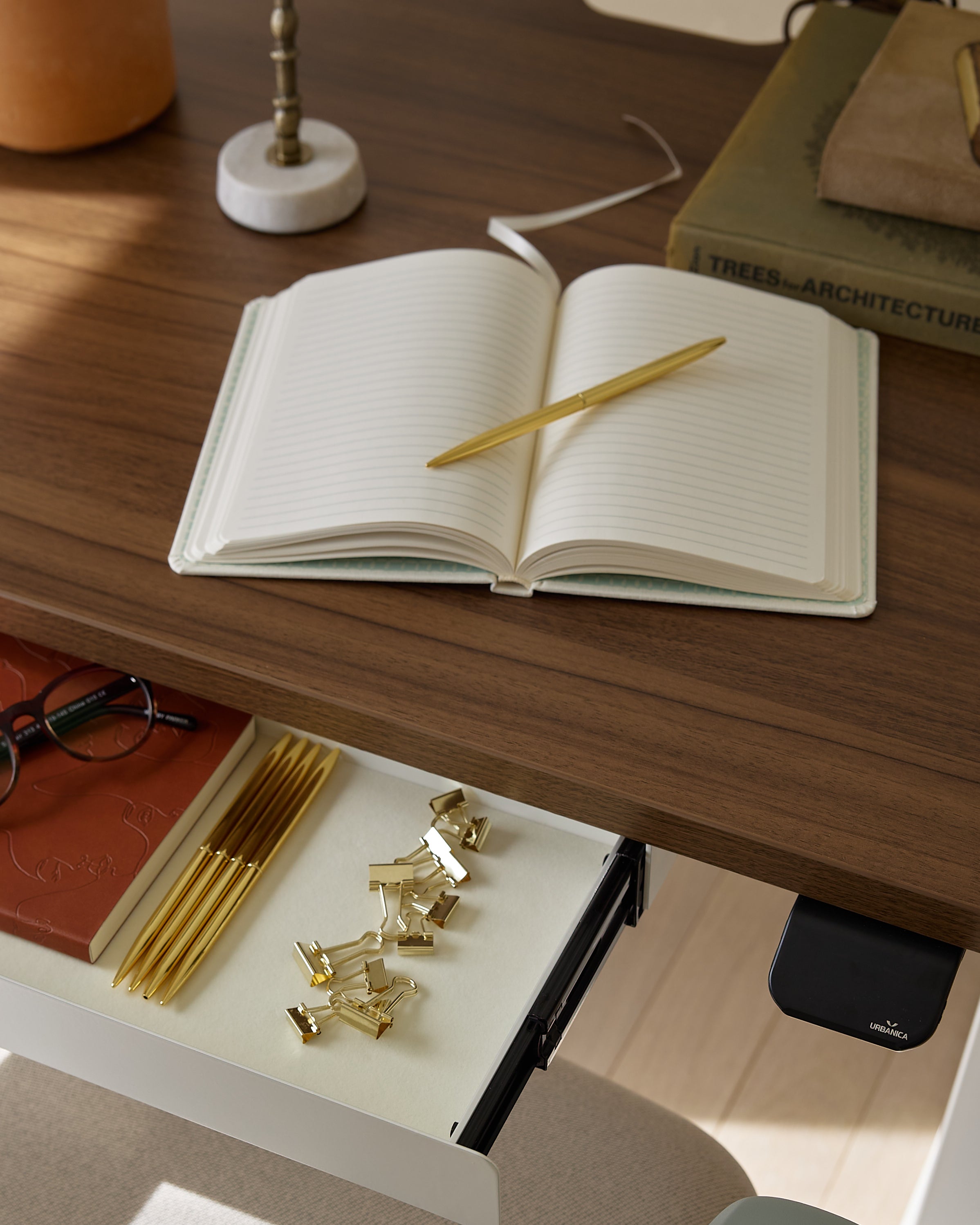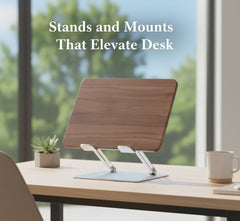Get 10% off your first order
Find the office furniture that’s designed to match your style, comfort, and needs perfectly. Subscribe
Low-Profile Desks Built for Laptop Power Users

Visit quiz page to see how we makes it easy to create an inspiring workplace


Armrests may look like minor features, but they define how the entire upper body relaxes while seated. Correct support balances the elbows and shoulders, letting the arms rest naturally instead of hovering over a desk. Over time, this reduces stiffness in the neck and helps the body maintain alignment without conscious effort.
Dining chairs, lounge chairs, and work chairs all support the arms differently. The more adaptable the armrest, the better it fits individual proportions, especially for long hours of sitting.
When wrists and hands are suspended or pressed too high, tension travels up the arms into the shoulders. The right armrest alignment keeps energy directed toward work instead of muscle correction.
As more people move between creative and professional tasks from home, comfort has become a design priority. Chairs that offer flexible armrest control reduce adjustment time and promote a consistent posture.
Many home setups rely on standard chairs that lack adjustability. Even the simplest armrest controls can make a major difference for hybrid workers.
When physical comfort remains stable, it allows focus to shift entirely toward the task at hand.
Proper armrest height keeps the elbows at about ninety degrees, reducing shoulder lift and protecting the spine from long-term stress.
Elbows should rest level with the work surface. Even a few centimeters of imbalance can cause ongoing discomfort.
When arms are unsupported, the shoulders compensate by lifting, which leads to curved posture. This repeated imbalance often causes upper back tension.
Reference: CDC’s ergonomic guidance
Many users never change the height of their armrests after assembling a chair. Height adjustment ensures that arms rest at a relaxed angle and prevents raised shoulders.
Example: The Novo’s armrest system provides controlled vertical adjustment that helps relieve shoulder pressure during extended work sessions.
High desks may require armrests to be slightly elevated, while compact desks benefit from lower settings that maintain alignment with the tabletop.
Relax the arms and raise or lower the rests until the shoulders naturally drop without force.
Armrests positioned too far forward pull the shoulders away from the spine, while ones that sit too far back limit elbow support.
Leave a small gap between the inner elbow and the chair’s edge to maintain healthy circulation.
Pull armrests closer when typing or sketching to maintain precision, and push them back slightly during casual reading or phone use.
Pivoting armrests rotate inward or outward to match the natural rotation of the arms. This helps maintain a neutral wrist angle.
Inspired by the Muse Chair’s arm design, these small pivots encourage relaxation during creative or office work.
Inward angles are ideal for tasks that involve keyboards or tablets.
Wider angles open the chest and support the arms in a more reclined position.
The distance between armrests should match shoulder width. A setting that is too narrow restricts movement, while one too wide causes elbows to flare outward.
Measure the span from elbow to elbow while sitting upright and align the rests accordingly.
Many users assume armrests are fixed after setup. Over time, failing to readjust them causes postural drift.
3D and 4D armrests refer to multiple directions of movement, including height, width, depth, and rotation. The Ergonomic Onyx Chair’s dynamic arm offers precise flexibility that adapts to varied sitting styles.
Three-dimensional adjustment typically means up, down, and sideways motion, while 4D adds pivot control for fine-tuned support.
Frequent micro-adjustments relieve static pressure and enhance comfort during long work hours.
The best armrest designs combine ergonomics with visual simplicity. The Seashell Chair’s minimalist comfort aesthetic shows how elegant design can still provide tactile stability.
Streamlined mechanisms reduce friction and make adjustments more inviting.
Light hues and smooth materials promote calm and focus, subtly improving the work atmosphere.
Easy-to-reach buttons and smooth motion make users more likely to adjust their chairs regularly.
Familiar controls foster habit formation and user engagement.
Raised shoulders indicate that armrests are too high. Lower them until the shoulders relax naturally.
Tension builds slowly, often mistaken for general stress rather than posture-related strain.
Pressure at the wrong point of the forearm restricts circulation.
A small angle correction or a softer pad can significantly improve comfort.
Excessively soft armrests can collapse under weight, leading to uneven support.
Firm yet cushioned surfaces maintain support without trapping the elbows.
Common Discomforts vs. Likely Armrest Causes
| Discomfort | Common Cause | Simple Fix |
|---|---|---|
| Shoulder fatigue | Armrests too high | Lower slightly |
| Wrist pain | Armrests too far apart | Move inward |
| Neck stiffness | Uneven height | Level both sides |
| Tingling fingers | No pivot | Enable inward angle |
Conscious alignment reduces small muscular contractions that accumulate fatigue.
At intervals, let the arms hang loosely to test whether tension has built up during work.
Physical ease supports steady breathing and sustained concentration.
A neutral posture frees cognitive energy for creativity and decision-making.
Brief check-ins prevent slouching and restore alertness.
Use short breaks to reset body alignment.
Small posture resets combined with mindful breathing refresh both body and focus.
Armrest adjustments work best when the neck and shoulders align. The Novo adjustable headrest upgrade supports upper spinal comfort by aligning with the chair’s existing design.
A balanced head position prevents upper-back compensation.
Different tasks require unique configurations. The Muse headrest accessory allows users to personalize posture for reading or screen time.
Households with multiple users benefit from quick adaptability.
Choosing accessories from the same design line ensures consistent fit and finish.
Cohesive designs enhance both aesthetics and comfort.
Adjust the seat height first, then armrests, followed by recline tension.
Correct lower body position before fine-tuning upper support.
Elbows, knees, and hips should each rest at roughly ninety degrees.
Keep forearms parallel to the desk surface without lifting shoulders.
Mirrors or phone cameras help confirm that wrists and shoulders remain level.
Placing small markers on the desk edge or armrest helps track ideal posture.
The Five Quick Armrest Calibrations Every User Should Know
1. Adjust height so shoulders stay neutral.
2. Pivot slightly inward for typing tasks.
3. Keep wrists level with the desk.
4. Balance lateral spacing with shoulder width.
5. Reassess weekly as posture evolves.
Consistent support lowers daily fatigue and encourages healthier sitting habits.
Physical ease supports calm focus and smoother transitions between tasks.
Fewer adjustments can still promote active comfort when used thoughtfully.
Small mechanical motions, like setting the arm height, become mindful rituals.
For users who switch between focus work and creative play, adaptive furniture offers stability without rigidity.
Explore more through Urbanica’s ergonomic chair collection.
People are more likely to modify environments they understand visually.
Clearly marked controls make posture adjustment intuitive.
When furniture reacts fluidly, users naturally adjust positions more often.
Familiar controls foster a sense of balance within the workspace.
A freelance designer noticed fewer headaches after aligning arm height and desk level. The improvement came not from major changes but from noticing the chair’s full potential.
Future design trends emphasize posture awareness and user adaptability without unnecessary complexity.
Furniture that supports attention to comfort will remain most useful.
Durability and repairability matter as much as adjustability.
Sustainable choices ensure long-lasting structure and consistent comfort.
The next generation of chairs will focus on refinement, simplicity, and adaptability rather than excessive features.
True comfort endures through subtle engineering and conscious use.
A few minutes spent finding the right armrest height can prevent years of strain.
Comfort is a habit built from small, consistent actions.
Posture responds best when treated as something adjustable rather than fixed.
Every mindful adjustment contributes to physical balance and ease across the day.

Low-Profile Desks Built for Laptop Power Users

Stands and Mounts That Elevate Desk

Table Bases That Won’t Wobble Over Time
Get 10% off your first order
Find the office furniture that’s designed to match your style, comfort, and needs perfectly. Subscribe
Leave a comment